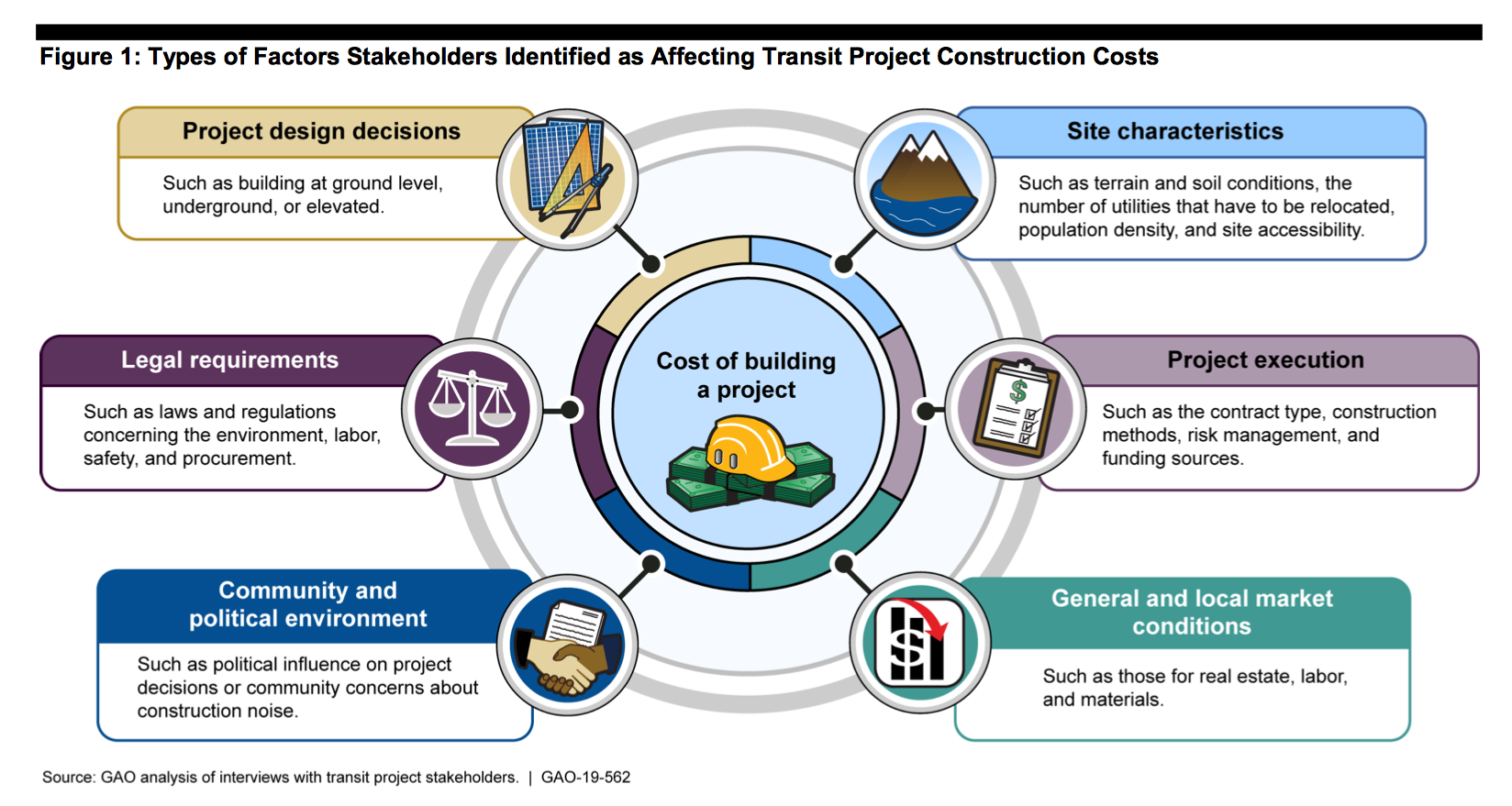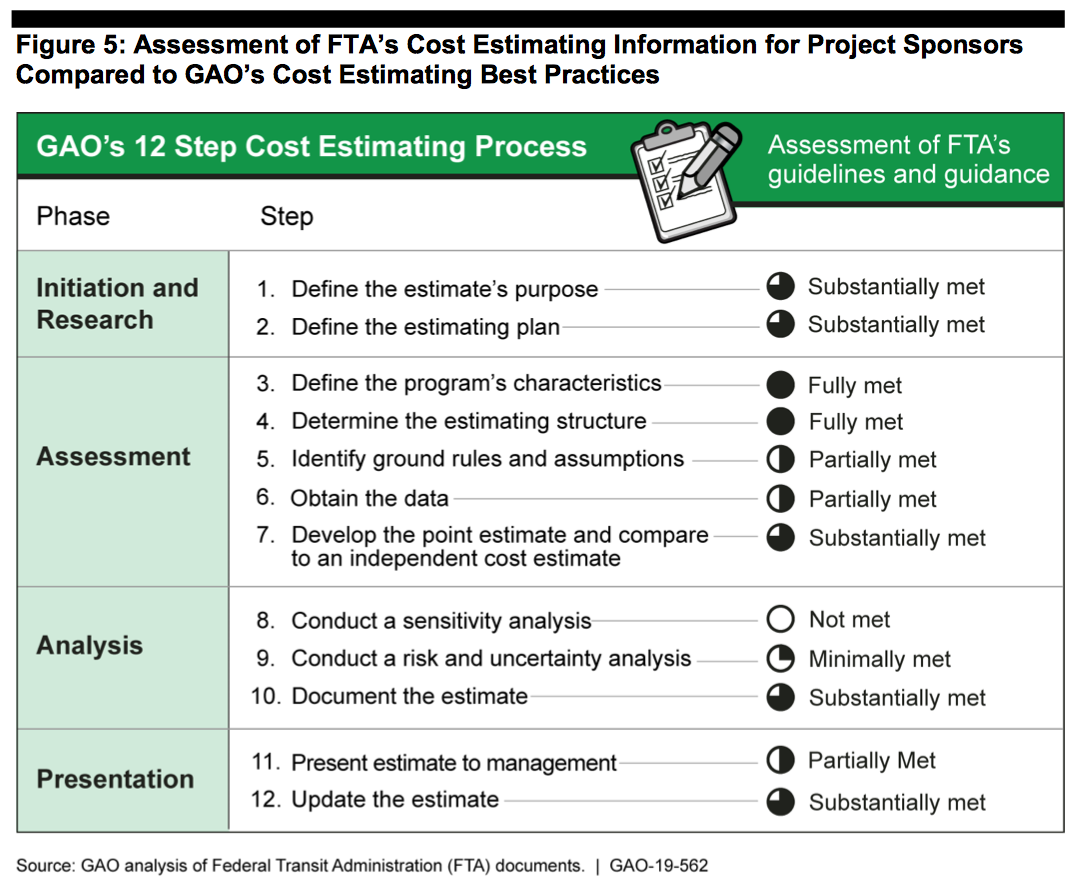This week, the U.S. Government Accountability Office issued a new report recommending that the Federal Transit Administration expand and improve its cost estimating procedures for rail transit projects and the cost estimate guidance it gives to local transit agencies.
Congress commissioned the study. The Senate Appropriations Committee tried to order a study in the fiscal 2017 DOT appropriations bill. Senate Report 114-243 (on page 71) required GAO to “report to the House and Senate Committees on Appropriations regarding the construction costs of transit capital projects in the United States in comparison to other developed G–20 nations, such as South Korea, Japan, Spain, France, Italy and Germany.” But then, a few months later, in the explanatory statement in the Record for the final version of the bill, that was preempted with “GAO is no longer directed to report on the construction costs of transit capital projects in the United States” (see here on page H4084).
The following year, the Senate tried again, in the fiscal 2018 appropriations bill – on page 80 of S. Rept. 115-138, the Committee ordered GAO to report “regarding the construction costs of transit capital projects in the United States in comparison to other developed G–20 nations, such as South Korea, Japan, Spain, France, Italy and Germany. The GAO shall examine potential cost drivers, including: contracting and procurement, project and station design, routing, regulatory barriers, interagency cooperation and legal systems, but not those which are required by Federal law. The report shall compare practices both between various cities in the United States, as well as practices in other nations.”
This time, the appropriators did not formally retract their request. But they may have agreed to scale the request back informally – because GAO is an instrument of the legislative branch, and the report that was turned in this week was not nearly as ambitious as what the Senate ordered.
No international comparisons. GAO said it could not really compare U.S. projects with other countries: “the availability and comparability of international rail transit project cost data limits comparisons between projects. Stakeholders mentioned limitations such as sponsors’ and contractors’ reluctance to report cost data, differences in how sponsors and contractors categorize and report costs, and differences in what costs are included in estimates.” Also, GAO interviewed numerous stakeholders and academics for the study, and many pushed back against the idea of comparing unique, snowflake-like projects to each other: “one academic expert contended that project costs cannot be compared without considering the context of each project, and that analysis of projects should focus on leading practices and lessons learned instead.”
In the international comparison field, the GAO study did note that there is hope on the horizon: “in 2017, to address the absence of international standards for categorizing and reporting construction project costs, the International Construction Measurement Standards Coalition (Standards Coalition) published a set of international standards for that purpose. However, Standards Coalition officials said that adoption of these standards is still in an early stage, and data that would allow for comparisons between projects using the standards are not yet available.”
Many factors affect transit project costs. The GAO study identified a wide variety of different classes of factors that can make a big difference to how one transit project’s cost compare with another’s. They summed it up in a great infographic (seriously – whoever their infographic person is should get a raise):

The study then cited a lot of individual examples of cost overruns from many of these sources: utility relocation (Honolulu), labor cost escalation (L.A. Westside), sponsor inexperience with design-build (San Fran BART to SFO), overly expensive design elements (NYC Second Avenue Subway), and scope/design changes (Norfolk light rail).
Case studies. The GAO analysis selected four projects as case studies to see how they managed costs and risks, chosen on the basis of geographic diversity and project type diversity:
Notably absent from the case studies are the three “problem children” of the recent/ongoing CIG portfolio: NYC Second Avenue Subway Phase 1 (completed, but $700 million over budget), NYC East Side Access (ten years delayed and $5 billion over budget), and Honolulu (construction interrupted partway through, on hold, and over $4 billion over budget).
Recommendations. GAO confined its recommendations to things that the FTA could actually do on its own to, in GAO’s view, make things better. There were two main recommendations for the FTA Administrator:
- “provide a central, easily accessible source with all of FTA’s cost estimating information to help project sponsors improve the reliability of their cost estimates.” This sounds like a no-brainer.
- “ensure that FTA’s cost estimating information for project sponsors is consistent with all 12 steps found in GAO’s Cost Estimating and Assessment Guide and needed for developing reliable cost estimates.”
The latter recommendation got some pushback from FTA. The following infographic shows GAO’s current 12 steps and how GAO says the current FTA cost estimating procedures measure up:

The big discrepancies are the requirement for a “sensitivity analysis” (which GAO defines as “changing the value of a single cost element and recalculating the cost, then comparing the original estimate with the recalculated estimate to understand how sensitive the estimate is to a particular change”) and the nature of FTA’s existing risk and uncertainty analysis, which GAO finds wanting.
Per the report: “According to FTA officials, FTA does not provide information on conducting a sensitivity analysis because FTA requires sponsors to identify and manage risk at the project level. Moreover, FTA officials said that a sensitivity analysis would not help FTA understand how project costs may increase overall. However, sensitivity analyses may help sponsors counteract some of the reasons a project’s costs can exceed estimates, a situation that we have previously discussed. In particular, such analyses may help sponsors anticipate additional risk factors and determine how much to allot for contingencies. In addition, sensitivity analyses allow sponsors to know which risk factors have the greatest impact on cost estimates and to analyze trade-offs in mitigating those risks.”
Also per the report: “FTA’s documents do not discuss how sponsors should evaluate and incorporate risk and uncertainty into the cost estimates they provide to FTA. Cost estimates are associated with risk and uncertainty for several reasons, some of which we’ve previously discussed: (1) there is always a chance that the actual cost will differ from the estimate, (2) there is always the possibility of error as a result of historical data inconsistencies, assumptions, cost estimating equations, and factors typically used to develop an estimate, and (3) cognitive or motivational biases. Given this uncertainty, making good predictions about how much funding a project needs for success is difficult.”
FTA responded that they perform a project-based overall risk assessment, but GAO said that “While assessing risk at the project level may be practical for sponsors and FTA to manage project-wide risks, this approach does not provide reasonable assurance that sponsors have evaluated risk and uncertainty by each cost element.”
The report contains an official response from USDOT via the Deputy Assistant Secretary for Administration: “Upon review of the GAO’s draft report, FTA partially concurs with [the recommendation] to ensure that FTA’s cost estimating information is consistent with all 12 steps in GAO’s Cost Estimating and Assessment Guide (Cost Guide) for developing reliable cost estimates. FTA agrees to post GAO’s Cost Guide to its website, and FTA encourages project sponsors to follow industry best practices. FTA concurs with [the other recommendation] to provide a central, accessible source for cost estimating information for project sponsors. We will provide a detailed response for each recommendation within 180 days of the final report’s issuance.”
It should be noted that everything in the recommendations deals with advice FTA gives to transit agencies. But sometimes, local transit agencies just don’t listen, with disastrous results. This little nugget was in the GAO report: “FTA and its oversight contractors expressed concern with the Honolulu Authority for Rapid Transportation’s overreliance on its contractors, in 2014, 2016, and 2018—and urged the transit agency to transition key management positions to its own employees to improve the agency’s ownership and strengthen its control of the project.”





